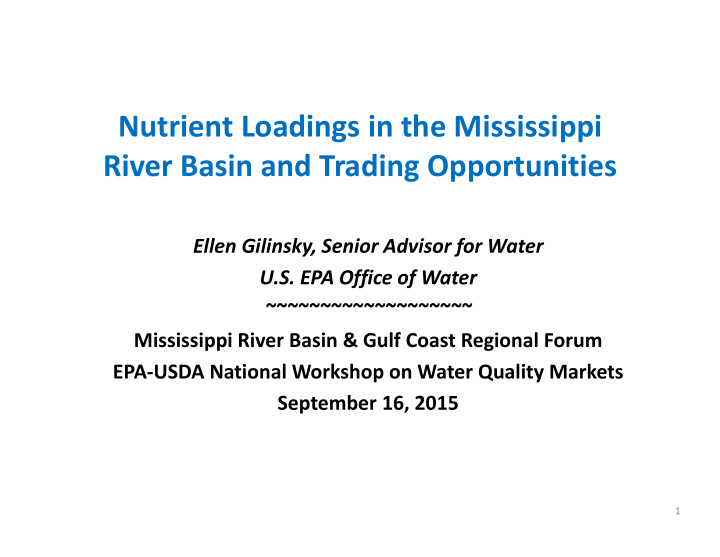



Nutrient Loadings in the Mississippi River Basin and Trading Opportunities Ellen Gilinsky, Senior Advisor for Water U.S. EPA Office of Water ~~~~~~~~~~~~~~~~~~~ Mississippi River Basin & Gulf Coast Regional Forum EPA ‐ USDA National Workshop on Water Quality Markets September 16, 2015 1
National Scope of Nutrient Problem Well Documented Problem and Impacts, e.g.: • EPA: Science Advisory Board (2007), Wadeable Streams and Lakes Assessments (2004, 2007) – National Research Council: Mississippi River Water Quality (2008), Urban Stormwater (2008) – USGS: Impact of Nutrients on Groundwater (2010), SPARROW Loadings (multiple years) – Many published articles, State and university reports – State EPA Nutrient Innovations Task Group (NITG) Call to Action Report – 15,000+ Nutrient ‐ related Impairment Listings in 49 States…an underestimate • – 2.5 Million Acres of Lakes and Reservoirs & 80,000 Miles of Rivers and Streams – >47% of Streams have Med to High Phosphorus; >53% have Med to High Nitrogen 78% of Assessed Continental U.S. Coastal Area Impacted by Eutrophication • 168 Hypoxic Zones in U.S. Waters, including immense zone in Northern Gulf • of Mexico Public Health Risks – Contaminated Drinking Water is Significant & Costly • – Rate of nitrate violations in community water systems doubled over past 7 years – Harmful Algal Blooms an emerging concern , including 2014 Toledo, OH crisis 2
What are the N & P Sources? Municipal Wastewater Treatment • Treats >18 million tons of human waste annually – >16,500 municipal treatment system permitted, some treat to remove Nitrogen (N) or – Phosphorus (P) but many do not yet monitor for or comply with N or P limits Atmospheric Nitrogen Deposition • Regulations in place, more underway – Loadings can be significant, e.g., 21% in Chesapeake Bay, 16% in Gulf of Mexico – Urban Stormwater (SW) • 80% of U.S. population lives on 10% of land, 50% pop. near coastal areas – 50% of urban landscape will be redeveloped by 2030, additional undeveloped land will be – developed Agricultural Livestock • $130 Billion Industry , >1 billion tons of manure produced annually , largely unregulated at – federal level, variable state controls Agricultural Row Crops • $120 Billion Industry, in many areas a significant source of N&P – Ag SW Runoff and Irrigation Return Flows Exempt from CWA, variable State controls – 3
Where do Nutrients to the Northern Gulf of Mexico Come From?
Environmental Impact of Nutrient Loadings to the Northern Gulf of Mexico Annual Hypoxic Zone Size 25,000 Hypoxic Area (square kilometers) 20,000 5-yr average 15,000 Long term 10,000 Average 5,000 Hypoxia Task Force 0 1985 1986 1987 1988 1989 1990 1991 1992 1993 1994 1995 1996 1997 1998 1999 2000 2001 2002 2003 2004 2005 2006 2007 2008 2009 2010 2011 2012 2013 2014 (HTF) Goal Source: N. Rabalais
Hypoxia Task Force (HTF) Group of 12 States and five federal agencies established in 1997 to: • – Understand causes and effects of hypoxia in the Northern Gulf of Mexico – Coordinate activities to reduce the size, severity and duration of Gulf hypoxia HTF Goal (revised 2015): • – Reduce the five ‐ year running average areal extent of the Gulf of Mexico hypoxic zone to less than 5,000 square kilometers by 2035. HTF Interim Target: • – Reduce nitrogen and phosphorus loading to the Gulf by 20% by 2025 – 45% reduction of both N and P ultimately needed HTF commitment to develop point and nonpoint source measures of • progress – First point source measure: N and P monitoring and limits for major sewage treatment plants; exploring load reduction measures – Nonpoint source measures under development All 12 HTF States now have draft or final nutrient reduction strategies • 6
How Do We Reach the HTF’s Goal/Opportunities for Trading? • State nutrient reduction strategies are key to reaching HTF goals • State strategies recognize the need for significant reductions from ALL source sectors • Need to reduce point source loads will create trading opportunities – All 12 state strategies consider trading as a tool for reaching reduction goals 7
Recommend
More recommend